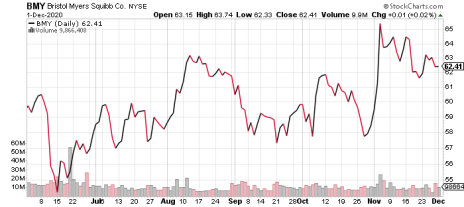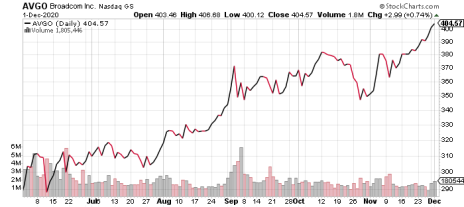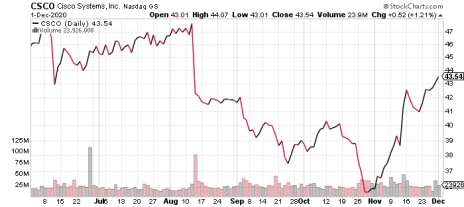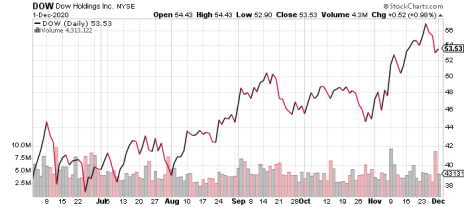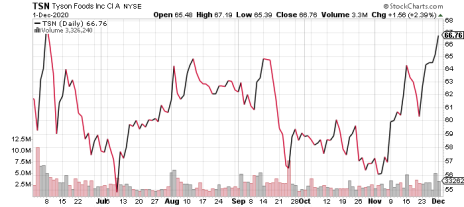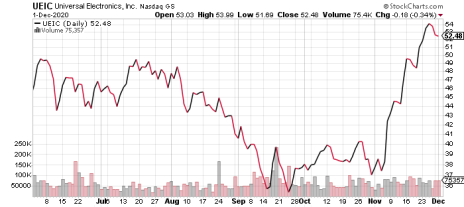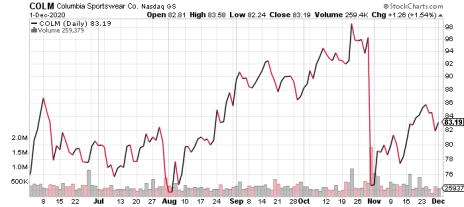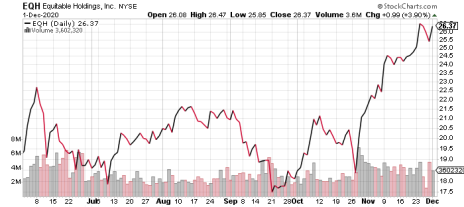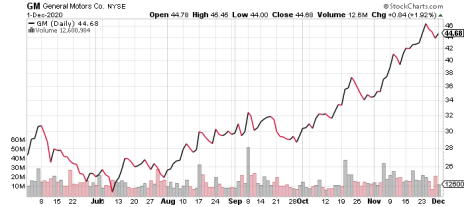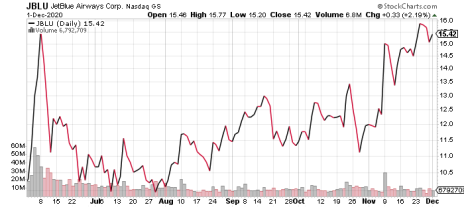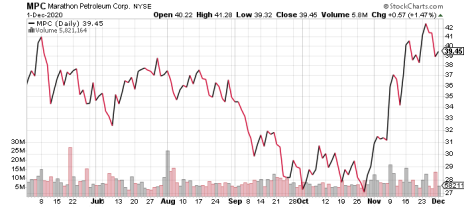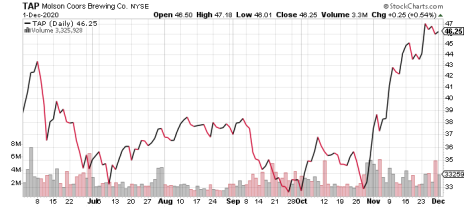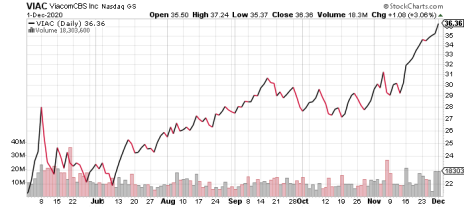Thank you for subscribing to the Cabot Undervalued Stocks Advisor. We hope you enjoy reading the December 2020 issue.
We briefly share our thoughts on the surging stock market and run through some valuation math that looks out a few years. Our conclusion: the market’s earnings growth, even side-stepping the pandemic’s effects, doesn’t look that impressive, while the market’s valuation is on the high side of average. It is starting to look like a good time to be pickier about which stocks to own.
With this thought in mind, we are moving Broadcom (AVGO) from a Hold to a Sell, as the shares have essentially reached our price target.
It’s been a fairly active month for a value-oriented newsletter, adding three new names and selling six, including Broadcom. This leaves the holdings list at 12 names. We anticipate expanding this roster over the next month or two, as there are many interesting value ideas out there.
We also tweaked the descriptions under the portfolio titles to more accurately reflect what types of stocks we look for. This should also help add some clarity to the differences between the two categories.
Please feel free to send me your questions and comments. This newsletter is written for you and the best way to get more out of the letter is to let me know what you are looking for.
I’m best reachable at Bruce@CabotWealth.com. I’ll do my best to respond as quickly as possible.
Cabot Undervalued Stocks Advisor 1220
[premium_html_toc post_id="220962"]
Some Thoughts on the Surging Stock Market
Stocks have surged this past month, with the S&P 500 returning 11% in November. Other major indices, including the Dow Jones Industrial Average and the Nasdaq Composite, produced similarly strong returns. These kinds of returns would make a good year in most investors’ eyes.
For the year-to-date, the S&P 500 has generated a 14% return – a very respectable gain for any year. That it occurred in a year like 2020, with a global pandemic that shut down much of the economy, a domestic presidential change-over, social unrest, and countless other unusually disruptive events is truly remarkable. If one woke up after an 11-month snooze to see the market producing a 14% return, they’d probably shrug it off as a decent year and wonder if anything worthwhile happened while they were sleeping.
On estimated 2021 earnings of about $169, the S&P 500 sells at a 21.7x multiple. If earnings grow 12%, to $190, in 2022 (which may be considered a fully post-pandemic year), the market sells at about 19.3x.
Compared to historical averages of 15x-17x, this 2022 multiple seems a bit high, especially for a period that is two years away. A lot can happen in those two years. One risk is that corporate income tax rates increase, perhaps to 28% as proposed by president-elect Biden, from the current 21% rate. Such a change would, on average, reduce corporate profits by about 9%. We have no insight into the likelihood nor merits of this possible change in tax rates, but are nevertheless alert to this risk.
If S&P 500 earnings reached $190 in 2022, it would be a record-high level yet wouldn’t actually be very impressive. Compared to 2018, the earnings would only be about 18% higher – nice but would represent only a sub-par 4% annual growth rate. And, earnings in 2018 were boosted by the huge tax rate cut from 35% to 21%. A partial reversal of that cut wouldn’t exactly flatter the outlook for earnings growth.
Our take on all of this: predicting the market is impossible, but it is starting to look like a good time to become pickier about which stocks to own
Share prices in the table reflect Tuesday (December 1) closing prices. Please note that prices in the discussion below are based on mid-day December 1 prices.
Note to new subscribers: You can find additional color on recent earnings and other news on recommended companies in prior editions of the Cabot Undervalued Stocks Advisor on the Cabot website.
Send questions and comments to Bruce@CabotWealth.com.
Upcoming Earnings Releases
- None in December
Today’s Portfolio Changes
Broadcom (AVGO) – from Hold to Sell
Portfolio Changes During the Past Month
JetBlue Airways (JBLU) – new Buy
General Motors (GM) – raised price target from 45 to 49
Cisco Systems (CSCO) – new Buy
General Motors (GM) – from Buy to Hold
Universal Electronics (UEIC) – from Hold to Sell
Marathon Petroleum (MPC) – from Hold to Sell
Coca-Cola Company (KO) – new Buy
MKS Instruments (MKSI) – from Hold to Sell
Total S.A. (TOT) – from Hold to Sell
Universal Electronics (UEIC) – from Buy to Hold
Voya Financial (VOYA) – from Buy to Sell
Equitable Holdings (EQH) – from Strong Buy to Buy
General Motors (GM) – from Strong Buy to Buy
Molson Coors (TAP) – from Strong Buy to Buy
Marathon Petroleum (MPC) – from Buy to Hold
Columbia Sportswear (COLM) – from Hold to Buy
Growth & Income Portfolio
Growth & Income Portfolio stocks are generally higher-quality, larger-cap companies that have fallen out of favor, usually with some combination of good earnings growth and an above-average dividend yield. Risk levels tend to be relatively moderate, with reasonable debt levels and modest share valuations.
| Stock (Symbol) | Date Added | Price Added | 12/1/20 | Capital Gain/Loss | Current Dividend Yield | Price Target | Rating |
| Bristol-Myers Squibb (BMY) | 04-01-20 | 55 | 62 | 14.3% | 2.9% | 78 | Buy |
| Broadcom (AVGO) | 12-17-19 | 323 | 405 | 25.1% | 3.2% | 410 | Sold 12/2/20 |
| Cisco Systems (CSCO) | 11-18-20 | 42 | 44 | 3.2% | 3.3% | 55 | Buy |
| Coca-Cola (KO) | 11-11-20 | 54 | 52 | -3.5% | 3.2% | 64 | Buy |
| Dow Inc (DOW) | 06-05-18 | 68 | 54 | -21.7% | 5.2% | 60 | Hold |
| MKS Instruments (MKSI) | 02-19-20 | 117 | 140 | 20.0% | 0.6% | 130 | Sold 11/09/20 |
| Total S.A. (TOT) | 09-04-18 | 62 | 43 | -30.1% | 7.1% | 43 | Sold 11/09/20 |
| Tyson Foods (TSN) | 12-10-19 | 89 | 67 | -25.1% | 2.5% | 75 | Buy |
| Universal Electronics (UEIC) | 11-04-16 | 57 | 52 | -8.3% | — | 47 | Sold 11/18/20 |
| Voya Financial (VOYA) | 05-31-18 | 52 | 60 | 14.2% | 1.0% | 62 | Sold 11/11/20 |
Bristol-Myers Squibb Company (BMY) is a New York-based global biopharmaceutical company. In November 2019, the company acquired Celgene for a total value of $80.3 billion, including $35.7 billion in cash and $40.4 billion in stock. We are looking for Bristol-Myers to return to overall revenue growth, both from resilience in their key franchises (Opdivo, Revlimid, and Eliquis) and from new products currently in their pipeline. We also want to see the company execute on its $2.5 billion cost-cutting program which will likely remain intact with the MyoKardia acquisition.
Like most biopharma companies, Bristol frequently issues news releases regarding its various treatments. Unless they meaningfully either strengthen or weaken our view on the company, we likely won’t comment on them here.
There was no meaningful news on the company this past week.
BMY shares were flat in the past week. The shares have about 23% upside to our 78 price target.
The stock trades at a low 8.5x estimated 2021 earnings of $7.46 (essentially flat from last week). The 2.8% dividend yield is well covered by the company’s enormous $13.5 billion in free cash flow. BUY.
Broadcom, Inc. (AVGO) designs, develops and markets semiconductors (about 72% of revenues) that facilitate wireless communications. The company’s foundation is its #1 industry position in high performance RFIC (radio frequency integrated circuits), whose use in high-end smartphones has driven Broadcom’s growth and profits. About 25% of total revenues come from chips that go into high-end smartphones, with Apple providing about 20% of Broadcom’s total revenues. The company also provides software that runs technology infrastructure including telecom and corporate networks (about 28% of total revenue).
We are moving Broadcom to a Sell. The shares have essentially reached our 410 price target, which seemed modestly generous at the time we set it. We see no imminent issues for the company, as it appears to be reasonably well-positioned in the chip market. The company seems committed to and capable of paying its generous dividend.
However, we see some meaningful risks. Broadcom’s more recently acquired businesses, like CA (Computer Associates) and Symantec, may create a drag on growth as well as a limit on AVGO’s earnings multiple. Broadcom’s strategy of paying down excessive debt is great for value investors, but for the company to inspire growth investors it needs to show an ability to produce faster revenue growth. But the balance sheet may preclude deals big enough to accomplish that for at least the next year or perhaps more, and acquisition targets don’t appear to be cheap, either. The Apple exposure is a risk given that that company has discontinued using Intel’s chips in favor of its own, and we wonder if this strategy puts RFIC chips at risk eventually.
While estimates for 2021 show modestly respectable revenue (+8.4%) and earnings growth (+15%), estimates beyond that are lackluster (at 4% and 7%, respectively, for 2022). While the company’s earnings report on December 10th could drive growth estimates higher, the risk/return from a stock price perspective is unfavorable.
And, given the shares’ valuation on both an absolute basis and relative to its peers, we are similarly reluctant to raise the price target from here.
Where could we be wrong? If the company is able to leverage its other businesses to sell more chips, and if it becomes well-positioned to benefit from 5G’s roll-out, the shares could drive considerably higher.
AVGO shares have produced a 31% total return (including dividends) from both the December 2019 initial recommendation and since June 30, 2020. SELL.
Cisco Systems (CSCO) is a $48 billion (revenues) technology equipment and services company. About 72% of revenues are from equipment sales. Its Infrastructure Platforms segment produces routers, switches, and other gear that connect and manage corporate, government, telecom and other data and communications networks. The Applications segment offers a range of software and related services with a growing emphasis on cloud migration. The Security segment provides a full suite of network, email, and cloud software and services to control access and minimize external threats. Cisco leverages its one-stop-shop breadth of products, software, and services to provide customized packages that match each customer’s needs.
Founded in 1984, Cisco emerged as a dominant provider of internet gear, becoming one of the Silicon Valley tech darlings during the late 1990s dot-com bubble. However, due to its then-extreme overvaluation, as well as stagnant revenue growth (essentially zero growth in the past eight years), Cisco’s share price is now only about half its March 2000 peak. In recent years, the company’s core business has struggled against the rising adoption of cloud computing, which reduces the need for Cisco’s gear. CSCO shares remain down 12% year-to-date and down 25% from their recent high in mid-2019.
Cisco’s prospects are starting to improve, with changes that started at the top. In 2015, the company promoted veteran Chuck Robbins into the CEO role, starting a slow but steady process to reinvigorate its operations. A new CFO, Scott Herren, who previously helped lead a rebuilding of Autodesk in ways very similar to what Cisco is doing, will start in December.
Cisco is accelerating its efforts to remain relevant and increase its value. To provide more recurring revenues and reduce its dependence on one-time equipment sales, Cisco is shifting its business mix to a software and subscription model. Progress is encouraging, with 78% of software now sold on a subscription basis, compared to 71% only a year ago. Software sales are a source of growth (albeit slow) and now comprise 28% of total revenues.
A critical source of stability is Cisco’s strong reputation and its entrenched position within its customers’ infrastructure. As long as it can stay close enough to competitors’ offerings, the company should retain these valuable intangible assets.
The company has ramped up its cloud-based offerings after lagging in this critical category. Also, its Webex video conferencing (like Zoom, only more secure, robust, and innovative) has 600 million participants in the most recent quarter, nearly twice the March level. Overall, the cadence of new products and services across the board appears to be accelerating under Robbins’ leadership.
Financially, Cisco is highly profitable. Its adjusted gross margin is wide, at about 65%, and its net profit margin at nearly 27% is impressive. The company produced $15.4 billion in cash flow from operations last year (fiscal year ended in July) and will likely repeat that rate in the current year. This strength supports share buybacks and a generous dividend that yields 3.4%.
Its balance sheet carries $30 billion in cash, double the $14.6 billion in total debt. This cash hoard may be utilized to make acquisitions or to accelerate its share repurchase program. In per-share terms, the excess cash of about $3.55/share is equal to over 8% of Cisco’s market capitalization.
Cisco clearly has its challenges. While its second fiscal quarter guidance points to a 1% revenue decline, revenues fell 9% in the most recently completed first fiscal quarter. Cisco has a lot of work to do to convince investors that it can successfully navigate the secular changes in technology gear demand, along with overcoming near-term signing delays due to the pandemic.
The generous dividend yield and fortress balance sheet provide considerable valuation support. As the market recognizes the company’s improving transition, we believe the shares should trade at our 55 price target.
Arun Sarin resigned from the board of directors. A Cisco board member since 2009, Sarin is a respected former technology executive who is on several other boards including Accenture and Charles Schwab. Cisco will not replace Sarin, leaving the board at nine members, which we believe is about ideal.
Interested investors might want to tune into the company’s annual shareholder meeting, to be held on December 10. The link to listen is here.
CSCO shares rose 3% in the past week, and have about 26% upside to our $55 price target. The shares trade at a low 13.9x estimated FY2021 earnings of $3.15. This estimate was unchanged in the past week. On an EV/EBITDA basis, the shares trade at a discounted 9.5x multiple. BUY.
Coca-Cola (KO) is one of the world’s largest beverage companies. While it is best-known for its iconic soft drinks, the company has a strong portfolio of non-soda brands, including PowerAde, Fuze Tea, Glaceau, Dasani, Minute Maid and Schweppes. Nearly 40% of its revenues now come from non-soda products across the non-alcoholic spectrum, including juice/dairy/plant beverages, water/hydration drinks, tea and coffee, and energy drinks.
Its global distribution system of 30 million customer outlets offers it the capability of reaching essentially every human on the planet. This allows it access to growing emerging countries where its market share has considerable potential to expand.
Relatively new CEO James Quincey, who took the helm in 2017, is a highly-regarded company veteran with a track record of producing profit growth and making successful acquisitions. The $5 billion acquisition of Costa Coffee in January 2019, while perhaps ill-timed only a year in front of the pandemic, still offers considerable potential. It added nearly 3,900 coffee shops throughout Europe, China, India, and the Middle East, giving Coca-Cola a valuable entre into coffee as well as a new channel to expand its distribution.
To improve its global operations, Coca-Cola is reorganizing to become more effective and more efficient. The former 17 business units are being concentrated into nine operating units, with a stronger emphasis on building the connections between these units. Product category teams will focus on improving marketing as well as introducing new and innovative beverages. Innovation efforts will be more clearly driven by their ability to either significantly increase the number of new drinkers, their frequency of consumption, or the value (profit) per consumption. The company is also culling its vast portfolio of over 400 brands by 50% to focus on its highest-priority offerings.
To capture more of the value of Coca-Cola’s vast global scale, back-office administrative services are being centralized and standardized across the system. A sizeable round of staffing reductions (about 4,000) should lead directly to lower costs as well.
All of these changes should accelerate the number and success rate of new products while expanding the overall profits of the company.
While Coca-Cola has much more ground to cover to improve its image (and reality) of selling sugar-intensive beverages that are packaged in environmentally-insensitive plastic, the company is accelerating its efforts. Eighteen of its top 20 brands, including Coke Zero, are now either low/no sugar or offer a low/no sugar option with 29% of its total volume now in low/no sugar beverages. The company’s packaging has risen from only 3% recyclable to 88% recyclable, with many additional programs in place to further improve.
Coca-Cola has a sturdy balance sheet, with its $53 billion in debt well-covered by cash flow and partly offset by over $21 billion in cash/equivalents. Its $0.41/share quarterly dividend is also well-covered by solid free cash flow, and the company is committed to growing this dividend. It is targeting a 75% payout (of free cash flow) over time. The dividend yield is currently a respectable 3.1%.
Recent results point to a recovery from pandemic-depressed volumes. While second quarter global volumes fell 16%, and revenues fell 28%, third quarter volumes fell only 4% while revenues were only 9% below the prior year. Management commentary points to continued improvements in October. Third quarter revenues and profits were higher than consensus estimates, suggesting that investors don’t fully appreciate the strength of the company’s fundamentals.
Impressively, Coca-Cola’s comparable operating profit margin increased to 30.4% from 28.1% a year ago, despite lower revenues. When the higher-margin away-from-home business returns when restaurants, stadiums, and other venues re-open, the company’s margins could expand further. Comparable earnings per share fell only 2% compared to a year ago.
While near-term outlook is clouded by pandemic-related stay-at-home restrictions, the secular trend away from sugary sodas, high exposure to foreign currencies, and always-aggressive competition, the longer-term picture looks bright.
There was no meaningful news on the company this past week.
KO shares slipped 2% in the past week. The stock has about 22% upside to our 64 price target.
While the valuation is not statistically cheap, at 24.8x 2021 estimated earnings of $1.89 and 22.5x estimated 2021 earnings of $2.11 (both unchanged in the past week), they are undervalued while also offering an attractive 3.1% dividend yield. BUY.
Dow Inc. (DOW) is a commodity chemicals company with manufacturing facilities in 31 countries. In 2017, Dow merged with DuPont to temporarily create DowDuPont, then split into three parts in 2019 based on the newly combined product lines. Today, Dow is the world’s largest producer of ethylene/polyethylene, which are the world’s most widely-used plastics. Dow is primarily a cash-flow story driven by three forces: 1) petrochemical prices, which are often correlated with oil prices and global growth, along with competitors’ production volumes; 2) volume of chemicals sold, largely driven by global economic conditions, and 3) ongoing efficiency improvements (a never-ending quest for all commodity companies to maintain their margins).
Dow’s third quarter earnings report was encouraging: per share earnings fell 45% but well-ahead of the consensus estimate. Operating EBITDA, a scrubbed measure of cash operating profits excluding the various charges and gains, fell 20% from a year ago, largely due to weaker sales but partly offset by cost-cutting. Management commented that demand in China is basically back to pre-Covid levels, and provided an encouraging overall outlook.
Dow is making progress with its strategic goals. Free cash flow was healthy and, along with proceeds from asset sales, has allowed Dow to reduce its debt net of cash by 12%. This is fairly impressive given everything that has happened this year.
There was essentially no news on Dow in the past week.
Dow shares fell about 7% this past week, partly due to its sensitivity to any fears that the pandemic may slow global economic growth. Dow shares have about 12% upside to our 60 price target.
The shares trade at 17.0x estimated 2022 earnings of $3.16, although this is two years away. This estimate was unchanged this past week.
Valuation on estimated 2020 earnings of $1.40 is less meaningful as this assumes no recovery.
The high 5.2% dividend yield is particularly appealing for income-oriented investors. Dow is currently more than covering its dividend and management makes a convincing case that it will be sustained. However, there is a small risk of a cut if the economic and commodity recoveries unravel. HOLD.
MKS Instruments (MKSI) generates about 49% of its revenues from producing critical components that become part of equipment used to make semiconductors. MKS’s products are generally in the stronger segments of this currently healthy market.
Earlier this past month, we moved MKS Instruments (MKSI) to Sell, as the shares touched our 130 price target. We don’t see any imminent problems with MKS, particularly given their favorable earnings report last week. However, we see little justification for raising our price target.
MKSI shares produced a 13% price return since our new coverage began on June 30. SELL.
Total S.A. (TOT), based in France, is among the world’s largest integrated energy companies. We moved the shares to a Sell earlier this past month. The stock surged nearly 16% on the Pfizer Covid vaccine news, approaching our 43 price target. Total is doing many things right, but is also heavily exposed to commodity oil prices. The dividend is very appealing, but perhaps half of it (we think if they needed to cut it, they would cut it in half, not fully suspend it) is at risk should oil prices stay below $40 (Brent). At the sell date, Brent oil prices were about $43.50 – not much margin for error.
The shares produced a sizeable 40% loss since the initial recommendation in September 2018. While possible, we don’t see the shares having a high-enough chance of returning to the 60 price range in the foreseeable future to merit a continued Hold rating. Since our new coverage began on June 30, the shares have produced a flat total return. SELL.
Tyson Foods (TSN) is one of the world’s largest food companies, with over $42 billion in revenues last year. Beef products generate about 36% of total revenues, while chicken (31%), pork (10%), and prepared/other contribute the remaining revenues. It has the #1 domestic position in beef and chicken with roughly 21% market share in each. Its well-known brands include Tyson, Jimmy Dean, Hillshire Farms, Ball Park, Wright, and Aidells. As only 13% of its sales come from outside the United States, Tyson’s long-term growth strategy is to participate in the growing global demand for protein. The company has more work to do to convince investors that the future is brighter, particularly as it is more of a commodity company (and hence has lower margins) compared to its food processor peers.
Tyson reported good fourth quarter results, with revenues rising 5% from a year ago, while per share earnings of $1.81 were 50% higher than a year ago. Both numbers were ahead of consensus estimates, with earnings vastly higher (+52%) than the consensus estimate of $1.19. Overall volumes increased 6% while pricing was down about 1%.
Removing the impact on sales growth of an extra calendar week, sales fell 2%, with volumes down about 1.5% and prices down about 0.5%. Stronger beef (+3%) and pork (+1%) revenues offset weaker chicken (-8%) sales. Chicken prices fell 6% due to the ongoing over-supply conditions.
The adjusted operating profit margin of 9.0% was considerably stronger than the year-ago 6.3% margin, driven by favorable beef and pork prices. The margin would have been 1.7 percentage points higher but for $200 million of direct Covid costs.
Tyson’s fourth quarter guidance pointed toward continued but moderate improvements. Overall, it looks like Tyson’s annual earnings power is around $6.25/share, better than the $5.64 for fiscal 2020 and higher than most pre-Covid years. The company raised its dividend by 6% to $0.445 per quarter. Tyson’s recovery will remain volatile from quarter to quarter but is on the right track.
There was no meaningful news on the company this past week.
The shares rose 3% in the past week, essentially breaking out of the 58-65 trading range where the shares have been stuck since April. The stock has 12% upside to our 75 price target.
TSN shares currently trades at 11.8x estimated 2021 earnings of $5.69. This estimate ticked down a cent in the past week. Currently the stock offers a 2.5% dividend yield. BUY.
Universal Electronics (UEIC) is a major producer of universal remote controls for TVs and related gear. Earlier this past month, we moved Hold-rated UEIC shares to a Sell, as the shares surged to about 4% above our 47 price target. We saw limited near-term risk to Universal but were reluctant to raise our price target, either. For investors who purchased the shares at their recommendation price of 57 over four years ago, the 14% loss has no doubt been frustrating. For more recent buyers, the gains have been robust. SELL.
Voya Financial (VOYA) is a U.S. retirement, investment, and insurance company serving 13.8 million individual and institutional customers. Earlier this past month, we moved our rating on Voya to a Sell. Part of our motivation was that we lost confidence in Voya’s earnings quality, particularly given the opaqueness of insurance company earnings data in general and with Voya’s practice of running above-industry-norms levels of charges through the income statement. Also, the non-bargain valuation and paltry dividend yield offered little incentive to continue to hold the shares. We don’t see any imminent risk, but see no reason to linger, either. The shares have produced an 8% total return since our new coverage began on June 30. SELL.
Buy Low Opportunities Portfolio
Buy Low Opportunities Portfolio stocks include a wide range of value opportunities, often with considerable upside. This group may include stocks across the quality and market cap spectrum, including those with relatively high levels of debt and a less-clear earnings outlook. The stocks may not pay a dividend. In all cases, the shares will trade at meaningful discounts to our estimate of fair value.
| Stock (Symbol) | Date Added | Price Added | 12/1/20 | Capital Gain/Loss | Current Dividend Yield | Price Target | Rating |
| Columbia Sportswear (COLM) | 06-30-20 | 80 | 83 | 3.9% | — | 100 | Buy |
| Equitable Holdings (EQH) | 11-15-19 | 24 | 26 | 11.3% | 2.6% | 28 | Buy |
| General Motors (GM) | 12-31-19 | 37 | 45 | 22.3% | — | 49 | Hold |
| JetBlue (JBLU) | 11-25-20 | 16 | 15 | -2.4% | — | 20 | Buy |
| Marathon Petroleum (MPC) | 09-04-18 | 84 | 39 | -53.0% | 5.9% | 41 | Sold 11/18/20 |
| Molson Coors (TAP) | 08-04-20 | 37 | 46 | 25.9% | — | 59 | Buy |
| Terminix Global Holdings (TMX) | 10-13-20 | 45 | 51 | 13.2% | — | 57 | Buy |
| ViacomCBS (VIAC) | 08-26-20 | 28 | 36 | 31.8% | 2.6% | 43 | Buy |
Columbia Sportswear (COLM) produces the highly recognizable Columbia brand outdoor and active lifestyle apparel and accessories, as well as SOREL, Mountain Hardware, and prAna products. For decades, the company was successfully led by the one-of-a-kind Gert Boyle, who passed away late last year. The Boyle family retains a 36% ownership stake and Gert’s son Timothy Boyle remains at the helm.
After a disappointing third quarter, after which the stock fell sharply, as price-sensitive investors we raised COLM shares back to a Buy. We think the company low-balled its guidance, with its long-term earnings power impeded but pushed out into the future. It also announced personnel changes in several key operational roles. Columbia’s balance sheet remained solid.
There was no meaningful news on the company this past week.
Columbia’s shares fell 3% this past week and have about 21% more upside to our 100 price target.
The shares trade at 22.4x estimated 2021 earnings of $3.71. The earnings estimate is unchanged from last week. For comparison, the company earned $4.83/share in 2019. BUY.
Equitable Holdings (EQH) owns two principal businesses: Equitable Financial Life Insurance Co. and a majority (65%) stake in AllianceBernstein Holdings L.P. (AB), a highly respected investment management and research firm. Acquired by French insurer AXA in 1992, Equitable began its return to independence with its 2018 initial public offering as part of a spinoff. AXA currently owns less than 10% of Equitable. With its newfound independence, Equitable is free to pursue new opportunities.
The company is well-capitalized and has significant liquidity. Its diverse, high-quality investment portfolio is hedged against adverse changes in interest rates and equity markets. Equitable has continued its share repurchase program through the pandemic.
AllianceBernstein shares (AB) are modestly attractive in their own right. Our October 14th note has more color on AllianceBernstein.
Equitable’s third quarter results were good, adjusted per share earnings fell 9% but were 5% higher than consensus estimates. Equitable added to its excess capital and liquidity base. Overall, while its large variable annuities book may be vulnerable to market pullbacks, the company continues to slowly but steadily prove its stability and strength while returning cash to shareholders.
The company is targeting a 50-60% of earnings payout ratio in the form of combined dividends and share repurchases. Its recently announced agreement to transfer the financial risk on $12 billion of its retirement-income annuities to Venerable Holdings will add additional flexibility to repurchase an incremental $500 million in shares in 2021, on top of their previous repurchase commitments. Book value per share, excluding intangibles, fell 7% to $26.63. Book value including intangibles rose 32% to $36.05.
There was no meaningful news on the company this past week.
EQH shares slipped 1% in the past week and have about 7% upside to our 28 price target.
Like many insurance companies, investors often value Equitable on a book value basis. On this basis, EQH shares trade at 98% of its $26.63 tangible book value, a modest discount. We note that the book value will likely move around some in future quarters, depending on the timing of the mark-to-market of its private equity investments and other factors.
EQH shares are also undervalued on earnings, trading at 5.8x estimated 2020 earnings of $4.54 (unchanged in the past week). The shares offer a 2.6% dividend yield. BUY.
General Motors (GM) under CEO Mary Barra (since 2014) has transformed from a lumbering giant to a well-run and (almost) respected auto maker. The company has smartly exited many chronically unprofitable geographies (notably Europe) and trimmed its passenger car roster while boosting its North American market share with increasingly competitive vehicles, particularly light trucks. We consider its electric and autonomous vehicle efforts to be near industry-leading. We would say it is perhaps 75% of the way through its gas-powered vehicle turnaround, and is well-positioned but in the very early stages of its EV development. Its GM Financial operations are well-capitalized but may be tested as the pandemic unfolds. Near-term, the shares will trade based on progress with a federal stimulus plan, the pandemic, the general U.S. economic outlook, trends in light vehicle sales, its progress with alternative vehicles, and of course, its earnings.
GM produced a remarkable third quarter, with adjusted earnings increasing 65% from a year ago and nearly double the $1.43 consensus estimate. From a different perspective, the company’s revenues were the same as a year ago, but the $5.3 billion in adjusted operating profits was $2.3 billion, or 78%, higher. Its outlook is for a strong 2021, with perhaps a return to the $6.50 earnings per share range that it would otherwise have earned this year. GM’s balance sheet is sturdy, with Automotive segment cash exceeding Automotive debt again. GM Financial’s capital position remains sturdy.
The company restructured its deal with Nikola, greatly reducing the size and scope of the agreement. GM will not produce Nikola’s Badger truck, nor will it take any equity stake in Nikola. GM will, however, provide its fuel cell technology to Nikola, with Nikola making up-front payments. In effect, it appears that GM is treating Nikola like any other commercial customer. We have mixed feelings on this – while Nikola has turned out to be more vapor than reality, most early-stage emerging technologies are just that, and it takes some capital and engineering to convert that vapor into actual products/services that work. So, GM is essentially cutting Nikola loose and losing a possibly valuable brand in the process, but it is also crippling a likely future competitor.
The South Korean operations remain in a deadlock with the labor union there, as workers rejected a proposed labor deal.
This past week, GM shares fell by about 3%, yet remain essentially at their post-bankruptcy highs. The shares have about 9% upside to our newly-raised 49 price target.
GM shares trade at 9.5x estimated 2020 earnings of $4.74 and 7.6x estimated 2021 earnings of $5.90. While the 2020 estimate ticked down in the past week, the more important 2021 estimate increased by about 1%. HOLD.
JetBlue Airlines (JBLU) is a low-cost airlines company. Started in 1999 from JFK Airport in New York City, the company has grown to now serve nearly 100 destinations in the United States, the Caribbean, and Latin America. The company’s revenues of $8.1 billion last year compared to about $45 billion for legacy carriers like United, American, and Delta, and were about a third the revenues of Southwest Airlines ($22 billion).
Its low fares and high customer service ratings (with among the highest customer satisfaction ratings in the industry) have built a strong brand loyalty. Low costs, including its point-to-point route structure, have helped JetBlue produce high margins in prior years, particularly relative to the legacy carriers. Its TrueBlue mileage awards program is a recurring source of revenues, as it sells miles to credit card issuers.
The pandemic has sent JetBlue, and the entire industry, into a near-term depression. Its available seat miles (ASM – a measure of how may seats an airline flies) were only 42% of its year-ago level. Like its peers, JetBlue parked many of its jets, flew others less-frequently, and took middle seats off the market. On its in-service planes, it filled less than half of its available seats with passengers in the third quarter, further weighing on revenues which fell 76% in the quarter.
To help reduce its $6 million/day cash burn (cash outflows from operating losses and capital spending), JetBlue is aggressively cutting its costs. Also, per-gallon fuel prices are 40% cheaper than a year ago, easing what is typically its second-highest expense.
We think consumers are increasingly likely to return to flying. Good news on a Covid vaccine, the continued economic recovery, and pent-up demand are starting to bring back passengers, particularly the leisure traveler. Business travelers are more likely to be slower to return to air travel. Your chief analyst is one such leisure travel venturer, flying non-stop from Boston to San Diego recently (full disclosure: on JetBlue) with no Covid issues. JetBlue’s route base and customer profile make it likely to be among the first to see a step-up in traffic.
JetBlue’s cash balance of $3.1 billion gives it plenty of time to recover, given its shrinking cash burn, although its debt is somewhat elevated at $4.8 billion. While JBLU shares have jumped recently, and near-term it remains vulnerable to rising quarantine risks in the Northeast, its longer-term outlook is promising.
The shares carry more than the usual amount of risk, given uncertainties from the pandemic, fuel costs, labor issues, the ever-present risk of irrational competition, and the overall economy.
JetBlue recently said that its fourth quarter cash burn will likely be $6-8 million/day, up from earlier comments that it would be more like $4-6 million/day. The company blamed weaker booking trends and delays in cash refunds. However, air travel over the Thanksgiving holiday set pandemic-era records, suggesting perhaps some conservativeness in their cash burn estimate. Also, JetBlue and other airlines are working to secure another round of federal relief.
JBLU shares fell about 2% this past week and have 28% upside to our 20 price target.
The stock trades at 13.5x estimated 2022 earnings of $1.15. On an EV/EBITDA basis, the shares trade at 5.0x estimated 2022 EBITDA. BUY.
Marathon Petroleum (MPC) is a leading integrated downstream energy company and the nation’s largest energy refiner, with 16 refineries, a majority interest in midstream company MPLX LP, 10,000 miles of oil pipelines, and product sales in 11,700 retail stores.
We moved MPC shares to a Sell as the shares essentially reached our price target after a 37% surge. Industry conditions and outlook have improved, but from being heavily depressed to being only partly depressed. For at least the near-term and possibly the next year, there is considerable risk that conditions don’t actually improve much from here, and they may deteriorate. We note that consensus estimates are starting to tick down again. Also, there is heightened regulatory risk from the change-over in the U.S. presidency.
We recognize that there is also a chance that industry conditions improve a lot further. The future is of course unknowable, so with the shares no longer selling at a large discount, our valuation-driven edge faded. SELL.
Molson Coors Beverage Company (TAP) – The thesis for this company is straightforward – a reasonably stable company whose shares sell at a highly discounted price. One of the world’s largest beverage companies, Molson Coors produces the highly recognized Coors, Molson, Miller and Blue Moon brands as well as numerous local, craft, and specialty beers. About two-thirds of its $10 billion in net revenues are produced in the United States, where it holds a 24% share of the beer market.
Investors’ primary worry about Molson Coors is its lack of meaningful (or any) revenue growth as it has relatively few of the fast-growing hard seltzers and other trendier beverages in its product portfolio. Our view is that the company’s revenues are resilient, it produces generous cash flow, and is reducing its debt, traits that are value-accretive and under-priced by the market. A new CEO is helping improve its operating efficiency and expand carefully into more growthier products.
We anticipate that the company will resume paying a dividend mid-next year, perhaps at a $0.35/share quarterly rate, which would provide a generous 3.0% yield.
Molson Coors recent results showed that the company is making progress with its turnaround and that investors underestimate this progress. Net revenues fell 3.1% but were about 4% better than consensus estimates. Adjusted per share earnings were nearly 60% better than estimates. Underlying EBITDA was 1% higher than a year ago and 26% higher than estimates.
The company announced that it will be expanding its production capacity by 400% to accommodate surging sales of some of its seltzer and other new drinks.
TAP shares fell 1% in the past week and have about 27% upside to our 59 price target.
Consensus estimates for each year from 2020 to 2022 are currently $4.17. So, the shares trade at 11.2x this estimate for all three years. These valuations are low, although not the stunning bargain from a few months ago.
On an EV/EBITDA basis, or enterprise value/cash operating profits, the shares trade for about 8.3x estimates, among the lowest valuations in the consumer staples group and well below other brewing companies.
For investors looking for a stable company trading at an unreasonably low valuation, TAP shares have considerable contrarian appeal. Patience is the key with Molson Coors shares. We think the value is solid although it might take a year or two to be fully recognized by the market. BUY.
Terminix Global Holdings (TMX) is both a new company and an old company. While the name “Terminix” is one of the largest and most widely recognized names in pest control, the company was previously obscured inside of the ServiceMaster conglomerate. With the sale of its ServiceMaster Brands operations recently completed, the company changed its name to Terminix and started trading under the TMX ticker symbol on October 5th. The divestiture cleans up the company’s balance sheet. Terminix appears to have fully addressed its legal liability from deficient termite treatments, removing an overhang on its shares. A new CEO, Brett Ponton, former head of Monro (MNRO), joined in August. His leadership at Monro led to sales growth and a strong recovery in its share price. Our expectation is that he will bring sales growth, operational efficiency and integrity to Terminix, ultimately leading to a higher share price.
Terminix reported third quarter adjusted per share earnings of $0.26, on revenues of $512 million. Revenues increased 10% from a year ago, with residential revenues increased 4% while commercial revenues fell 3%. Acquired franchises and European franchises provided growth as well. Adjusted EBITDA of $98 million was healthy. Unusual expenses totaling $52 million weighed on the quarter, but likely won’t hold back future results.
There was essentially no news regarding the company this past week.
Terminix shares fell about 2% in the past week and have 15% remaining upside to our 57 price target.
Reliable consensus 2022 earnings estimates appear to be settling at around $1.43/share, about 11% below our initial estimate. This would put the TMX multiple at a high 37.7x, but we recognize that these types of companies are generally valued on EV/EBITDA. On this basis, the shares trade at about 17.5x EBITDA.
Major risks include the possibility of new disclosures that would significantly increase the company’s litigation expenses, difficult industry competition that may exert pricing pressure, and possible execution risks by the new leadership. TMX shares carry more risk than typical CUSA stocks, but if its litigation and sub-par margins are behind them, we see a clear path to a higher stock price.
With a reasonable valuation, solid balance sheet, renewed focus and better revenue and margin outlook, there is a lot to like about Terminix. BUY.
ViacomCBS (VIAC) is a major media and entertainment company, owning highly recognized properties including Nickelodeon, Comedy Central, MTV and BET, the Paramount movie studios, Showtime, and all of the CBS-related media assets. The company’s brands are powerful and enduring, typically holding the #1 market shares in the highest-valued demographic groups in the country. ViacomCBS’s reach extends into 180 countries around the world. Viacom and CBS re-merged in late 2019 and are now under the capable leadership of former Viacom CEO Robert Bakish.
Viacom is being overhauled to stabilize its revenues, boost its relevancy for current/future viewing habits, and improve its free cash flow. Its challenges include the steady secular shift away from cable TV subscriptions, which is pressuring advertising and subscription revenues. The pandemic-related reductions in major sports are also weighing on VIAC shares. However, ViacomCBS’s extensive reach, strong market position and strategic value to other, much larger media companies, and its low share valuation, make the stock appealing.
As part of its overhaul, Viacom is shifting away from advertising (currently about 36% of revenues) and affiliate fees (currently about 39% of revenues), toward content licensing – essentially renting its vast library of movies, TV shows, and other content to third-party firms like Netflix and others. Viacom is building out its own streaming channel (Paramount+) and other new distribution channels, which are generally showing fast growth. Ultimately, we think the company may be acquired by a major competitor, given its valuable businesses and content library, as well as its bite-sized market cap of about $20 billion.
Viacom reported a reasonably good third quarter, with adjusted profits down 17% from a year ago, but about 14% above consensus estimates. Revenues fell 9% but were slightly higher than estimates. The company generated $1.4 billion in operating cash flow and $1.3 billion in free cash flow. The cost-cutting program is well-underway and boosting cash flow. However, cash flow ultimately needs to be higher. So far this year, ViacomCBS has reduced its debt net of cash by about $1.5 billion, or 8%. Cash remains robust at $3 billion.
The company reached a deal to sell its Simon & Schuster publishing unit for $2.2 billion in cash to German publisher Bertelsmann. We view the price paid as relatively high, benefitting Viacom. Viacom will use the cash to reinvest in its business, fund its dividend, and reduce its debt.
VIAC shares rose about 6% this past week and have about 18% upside to our 43 price target.
ViacomCBS shares trade at about 8.3x estimated 2021 EBITDA, which we believe undervalues the company’s impressive leadership and assets. On a price/earnings basis, VIAC shares trade at 8.5x estimated 2021 earnings of $4.31 (estimate unchanged from a week ago). ViacomCBS shares offer a sustainable 2.6% dividend yield and look attractive here. BUY.
Strong Buy and Buy – This stock is worth buying.
Hold – The shares are worth keeping but the risk/return trade-off is not favorable enough for more buying nor unfavorable enough to warrant selling.
Retired – This stock has been removed from the portfolio, primarily for being fully valued. We generally view the company as fundamentally solid with few problems. Investors may choose to hold these shares to minimize portfolio turnover, seek to capture continued upward share price momentum, or other reasons.
Sell – This stock is approaching or has reached our price target, its value has become permanently impaired or changes in its risk or other traits warrant a sale.
The next Cabot Undervalued Stocks Advisor issue will be published on January 6, 2021.
Cabot Wealth Network
Publishing independent investment advice since 1970.
CEO & Chief Investment Strategist: Timothy Lutts
President & Publisher: Ed Coburn
176 North Street, PO Box 2049, Salem, MA 01970 USA
800-326-8826 | support@cabotwealth.com | CabotWealth.com
Copyright © 2020. All rights reserved. Copying or electronic transmission of this information is a violation of copyright law. For the protection of our subscribers, copyright violations will result in immediate termination of all subscriptions without refund. No Conflicts: Cabot Wealth Network exists to serve you, our readers. We derive 100% of our revenue, or close to it, from selling subscriptions to its publications. Neither Cabot Wealth Network nor our employees are compensated in any way by the companies whose stocks we recommend or providers of associated financial services. Disclaimer: Sources of information are believed to be reliable but they are not guaranteed to be complete or error-free. Recommendations, opinions or suggestions are given with the understanding that subscribers acting on information assume all risks involved. Buy/Sell Recommendations: All recommendations are made in regular issues or email alerts or updates and posted on the private subscriber web page. Performance: The performance of this portfolio is determined using the midpoint of the high and low on the day following the recommendation. Cabot’s policy is to sell any stock that shows a loss of 20% in a bull market or 15% in a bear market from the original purchase price, calculated using the current closing price. Subscribers should apply loss limits based on their own personal purchase prices.

